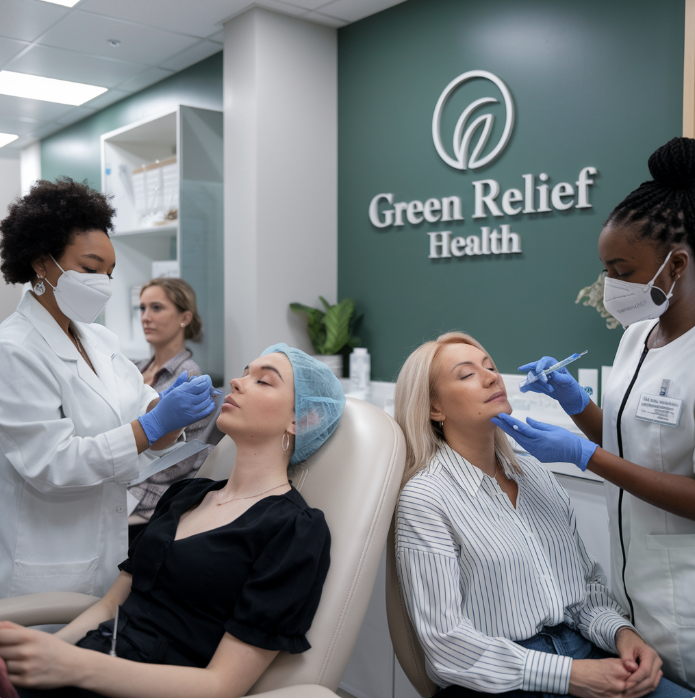HEALTH
7 Facts I Wish I Had Known Before Getting Botox

Botox has become one of the most popular non-surgical cosmetic treatments around the world, especially for smoothing wrinkles and fine lines. But like anything that sounds too good to be true, there’s always more to the story.
Having gone through the Botox experience myself, I wish I had known a few things beforehand. If you’re considering Botox, these facts could help you go in with a clearer understanding and more realistic expectations.
1. Botox is Not Permanent
One of the first things I learned (and wish I had known sooner) is that Botox isn’t permanent. When I first started exploring Botox, I assumed the effects would last indefinitely, or at least for a long time. The reality is that Botox typically lasts between three to four months. After that, the treated muscles gradually regain movement, and wrinkles start to reappear. You’ll need to plan for regular treatments if you want to maintain the results long-term.
While the idea of regular treatments might sound daunting, it’s actually one of the reasons many people love Botox. The temporary effect gives you the flexibility to stop if you decide it’s not for you or if you want to adjust your treatment plan down the line.
2. It’s Not Just for Wrinkles
A fact I hadn’t considered before getting Botox is its many other uses beyond wrinkle reduction. While it’s most famous for smoothing frown lines, crow’s feet, and forehead wrinkles, Botox can also be used to treat medical conditions. For instance, Botox is commonly prescribed for chronic migraines, excessive sweating (hyperhidrosis), and even certain bladder conditions.
For cosmetic purposes, Botox can subtly reshape your face by lifting your brows or softening a square jawline. I wish I had known how versatile this treatment could be. If I had, I might have considered trying it for other issues I was dealing with, not just my forehead lines.
3. Results Take Time
One of the more surprising things about Botox is how long it takes for results to show up. I mistakenly thought I would walk out of the appointment looking refreshed, but Botox doesn’t work immediately. Typically, you won’t start seeing the effects until around three to five days post-injection, with full results showing up at the two-week mark.
This lag time is due to the way Botox works—it blocks nerve signals to your muscles, which gradually causes them to relax. So, if you’re getting Botox for a special event, make sure to plan accordingly. Don’t expect to see a huge difference immediately after the treatment.
4. There’s a Chance of Minor Side Effects
While Botox is generally considered safe, I wish I had been more prepared for the possibility of minor side effects. After my first treatment, I experienced slight bruising and swelling at the injection sites. This is completely normal and temporary, but it’s something to be aware of. Some people also report mild headaches or a feeling of tightness in the treated area, which can last a few days.
The good news is that serious side effects are rare when a skilled professional administers Botox. If you go to a reputable clinic, like Green Relief Health in Baltimore, and have your treatment performed by an expert like Dr. Lauren Nawrocki, the likelihood of complications is minimized. Always make sure you’re in the hands of a certified and experienced practitioner.
5. Botox Isn’t as Painful as You Think
One of my biggest worries before getting Botox was the potential pain. I imagined needles being stuck in my face and wasn’t sure how tolerable that would be. However, the reality was much more manageable. Botox needles are extremely fine, and the procedure is quick. Most injections feel like a small pinch, and while some areas are more sensitive than others (like around the eyes), the discomfort is minimal.
If you’re particularly sensitive to pain, some providers offer numbing creams to make the experience even more comfortable. In my case, the whole process was over so quickly that I barely had time to feel anything at all.
6. It Won’t Freeze Your Face (Unless You Overdo It)
One of the most common myths surrounding Botox is that it leaves you with a frozen, expressionless face. Before my first treatment, this was one of my biggest concerns—I didn’t want to end up looking like I was constantly surprised or unable to smile naturally.
But the truth is when Botox is administered correctly and in moderation, it softens your expressions without taking away your ability to emote.
The “frozen” look typically happens when too much Botox is used or when it’s applied in the wrong areas. This is why it’s so important to go to a trained professional who understands facial anatomy and the right dosage for natural-looking results. I found that a good injector will ask about your goals and tailor the treatment to your preferences.
7. Maintenance is Key
Lastly, one thing I hadn’t fully grasped before starting Botox was the level of maintenance required. Botox isn’t a one-and-done treatment; to keep your face looking smooth and youthful, you’ll need to return every few months for a touch-up. The effects start to wear off gradually, and before you know it, your wrinkles will slowly begin to reappear.
While some people might find this upkeep burdensome, I personally found it manageable. It’s a small time investment for the results you get.
Additionally, some experts believe that regular Botox treatments can prevent deeper wrinkles from forming over time, as the muscles stay relaxed for extended periods. I’ve come to view it as a form of long-term skincare, much like getting regular facials or maintaining a good skincare routine.
Conclusion
Botox can be a fantastic option for those looking to reduce the appearance of wrinkles or treat certain medical conditions, but it’s important to go in with a clear understanding of what the treatment involves. Knowing that Botox is not permanent, that results take time, and that there’s a level of maintenance involved can help you set realistic expectations.
The versatility of Botox surprised me, and learning that it’s not as painful as I had imagined was a relief. Also, knowing the importance of choosing the right professional can’t be overstated. At Green Relief Health in Baltimore, Dr. Lauren Nawrocki provides expert Botox treatments with natural-looking results, ensuring patients feel confident and well-cared for.
If you’re considering Botox, make sure you’re informed and prepared, and don’t hesitate to consult a professional to determine if it’s the right choice for you. With the right approach, Botox can enhance your appearance without compromising your natural expressions, giving you the confidence boost you’ve sought.
FOOD & DRINKS
What are the Health Benefits of Adding Blue Swimmer Crabs to Your Diet?

More than a mere delicacy, blue swimmer crabs also offer a range of health benefits that make it such a valuable addition to your diet. Packed with essential nutrients and low in calories, a blue swimmer crab can contribute to overall well-being and support various aspects of health. Let’s explore the health benefits of adding blue swimmer crab to your diet.
Rich Source of Protein
If you’re an active person, here’s a good reason to learn how to cook blue swimmer crab. This seafood option is an excellent source of high-quality protein, essential for building and repairing tissues in the body. Protein is also important for supporting muscle growth, maintaining healthy hair and nails and keeping you feeling full and satisfied after meals.
Low in Fat and Calories
Despite its rich taste and texture, blue swimmer crab is relatively low in fat and calories, making it a healthy choice for those watching their weight or looking to maintain a balanced diet. By incorporating blue swimmer crab into your meals, you can enjoy a satisfying and flavourful dish without worrying about excessive calorie intake.
High in Vitamins and Minerals
Blue swimmer crab is packed with essential vitamins and minerals that are vital for overall health and well-being. It’s particularly rich in Vitamin B12, which supports nerve function and helps prevent anaemia.
In addition, blue swimmer crabs contain significant amounts of Vitamin C, Vitamin E, magnesium and selenium, all of which play important roles in various bodily functions.
Omega-3 Fatty Acids
Like many seafood, blue swimmer crab is a good source of omega-3 fatty acids, which are known for their heart-healthy benefits. Omega 3s help reduce inflammation in the body, lower triglyceride levels and support cardiovascular health. Incorporating blue swimmer crab into your diet can help reduce the risk of heart disease and improve overall heart function.
Promotes Bone Health
Blue swimmer crab is rich in minerals like calcium, phosphorus and zinc, which are all essential for maintaining strong and healthy bones. These minerals help support bone density, prevent osteoporosis and reduce the risk of fractures and bone-related disorders, especially as you get older.
Supports Immune Function
The vitamins and minerals found in blue swimmer crabs, such as Vitamin C, Vitamin E and selenium, play important roles in supporting immune function and helping the body fight off infections and diseases. By incorporating blue swimmer crabs into your diet, you can give your immune system a natural boost and stay healthy year-round.
Blue Swimmer Crab: Sumptuous and Nutritious
Still haven’t tried blue swimmer crabs? It’s time to incorporate them in your diet and reap a range of benefits from getting essential nutrients to enhancing your overall well-being. Whether you enjoy it steamed, grilled or in a delicious seafood pasta, this delicious seafood option is a versatile and nutritious addition to any meal. So, the next time you’re planning your menu, consider adding blue swimmer crab for a tasty and healthful dining experience.
HEALTH
The Surprising Benefits of Weight Loss Peptides You Need to Know

Peptides have long been heralded as the unsung heroes of biological processes. It plays important roles in everything from inflammatory responses to cell signaling.
However, their recent ascent into the limelight in the field of weight management may surprise many. Today, we’re taking a deep dive into the realm of weight loss peptides.
We’ll explore how these compounds promise a path to a healthier, more vibrant life. So, read on!
Increased Fat Loss
The primary mechanism of action behind weight loss peptides is their ability to increase fat loss. These compounds work by mimicking the effects of our body’s natural hormones. This includes growth hormone and insulin-like growth factor-1 (IGF-1).
By activating these pathways, they can promote lipolysis (the breakdown of fats) and inhibit lipogenesis (the creation of new fats). As a result, the body can burn fat more efficiently. It can prevent the storage of excess fat.
Additionally, peptides, particularly semaglutide peptides, may also increase metabolism and energy expenditure. This can lead to even greater fat loss.
Enhanced Metabolic Rate
Metabolism refers to the chemical reactions that occur in our body to maintain life. A faster metabolic rate means our body is burning more calories, even at rest.
Weight loss peptides have been found to stimulate metabolism by increasing thermogenesis. This is the production of heat in the body. This process requires energy and therefore burns more calories.
Moreover, certain peptides can also improve insulin sensitivity and glucose metabolism. This can benefit those with conditions like obesity or diabetes.
Preservation of Lean Muscle Mass
One of the biggest challenges in weight loss is maintaining muscle mass while shedding fat. This is where peptides can offer a significant advantage.
Certain peptides, such as growth hormone-releasing peptides (GHRPs), can stimulate the production of growth hormone and promote muscle building. This can help individuals preserve their lean muscle mass while losing fat. This can result in a more toned and defined physique.
Appetite Regulation
Weight loss peptides can also impact our appetite and food intake. Some peptides have been found to reduce hunger and increase satiety. This can help individuals stick to their weight loss goals by preventing overeating.
Moreover, by regulating the levels of hormones involved in appetite, peptides can also help individuals make healthier food choices and resist cravings for unhealthy foods. This can lead to long-term weight management success.
Improved Energy and Exercise Performance
The benefits of peptides for body weight loss treatment extend beyond just the physical changes. By increasing energy and endurance, these compounds can also improve exercise performance.
Some peptides have been found to enhance oxygen delivery and nutrient uptake in the muscles. This allows individuals to train harder and longer. This can result in more calories burned during workouts and ultimately contribute to weight loss.
As long as you get your supplements from the right provider like Top Semaglutide Provider, these compounds can be safe and effective in improving weight loss outcomes.
Discover the Surprising Benefits of Weight Loss Peptides
Weight loss peptides offer a multitude of benefits. Not only do they increase fat loss and improve metabolism. They can also preserve lean muscle mass, regulate appetite, and enhance exercise performance.
With these surprising advantages in mind, it’s no wonder that weight loss peptides are gaining recognition as powerful tools for weight management. Keep in mind that it is important to consult a healthcare professional before starting any new supplement regimen.
Should you wish to read more, visit our blog. We’ve got more topics!
HEALTH
Transitional Living’s Crucial Role in the Continuum of Addiction Recovery

In the process of transitioning from rigorous inpatient treatment for drug misuse to the independence of sober living situations, transitional living emerges as an essential bridge. It encompasses a one-of-a-kind strategy within the larger arena of addiction treatment programs, providing a structured recovery pathway for persons who are struggling with the difficulties associated with alcoholism or drug abuse.
The path of many people who are battling addiction often starts with a moment of confrontation and revelation, which is typically accomplished via the use of an intervention.
During these types of interventions, members of the client’s family and other loved ones get together to convey a unified front, asking the individual to accept their addiction and think about the many treatment alternatives available to them.
Note that this defining moment highlights the gravity of their circumstance, which is frequently characterized by the threat of broken relationships in the event that they refuse therapy.
Many people find themselves at a crossroads after completing the early rounds of therapy because they are unable to continue their stay in residential institutions due to budgetary concerns.
Transitional living is an alternative that is easily accessible and provides a continuum of care at a fraction of the expense of traditional residential care. By offering a framework that is both organized and flexible, this setting assists patients in consolidating the gains they have achieved during previous periods of treatment. It also provides a framework that is adapted to the unique requirements of recovery, including gender-specific activities.
Individual bedrooms are typically provided in transitional living facilities, which have a capacity restriction to ensure that each resident receives the individualized attention they require. This strikes a compromise between community assistance and personal privacy.
In comparison to more conventional forms of treatment, this environment is distinguished by the fact that it provides a larger degree of autonomy and responsibility. Participants are encouraged to participate in community service, look for jobs, and gradually reintegrate into society in order to cultivate a feeling of purpose and belonging in their lives.
The 12-step recovery paradigm is a fundamental component of transitional living programs. These programs need participants to maintain consistent involvement with support networks such as Alcoholics Anonymous or Narcotics Anonymous, and they also require daily interactions with sponsors.
The provision of travel and housing guarantees that the individual is able to concentrate on rehabilitation without being distracted by outside influences, while random drug screens reinforce accountability.
In addition, transitional living goes beyond only providing a place to sleep; it also incorporates educational programs, support groups, and tactics to avoid relapse into its overall structure. The aims of these components are similar to those of more intense treatment settings, and they are designed to help individuals learn essential living and coping skills.
Counseling sessions within these programs contain a wide range of therapeutic modalities, including individual therapy, family counseling, and marriage therapy, despite the fact that transitional care is less restrictive than other types of care. These sessions are led by qualified experts.
Furthermore, transitional living programs recognize the significant role that a supportive community plays in the rehabilitation process, and as a result, they provide a variety of support groups for families. Not only do these free tools offer essential assistance to individuals who are in recovery, but they also offer help to their families, which has the effect of aiding healing and understanding for everyone concerned.
The spectrum of addiction treatment programs includes transitional living, which acts as a vital component. Transitional living provides a balanced combination of structure, support, and freedom and serves as an essential component. Individuals are empowered with the resources and support necessary for a successful transition back into society when they participate in transitional living programs. These programs play a vital role in leading individuals toward long-term sobriety by creating an atmosphere that is favorable to continuous growth.

 ENTERTAINMENT4 days ago
ENTERTAINMENT4 days agoExploring the Kristen Archives: A Treasure Trove of Erotica and More

 ENTERTAINMENT1 day ago
ENTERTAINMENT1 day agoKiss KH: The Streaming Platform Redefining Digital Engagement and Cultural Currents

 EDUCATION1 day ago
EDUCATION1 day agoLingrohub Platform: A Complete Student Access Guide

 LIFESTYLE4 months ago
LIFESTYLE4 months agoThe Disciplinary Wives Club: Spanking for Love, Not Punishment

 TECHNOLOGY1 day ago
TECHNOLOGY1 day agoCasibom: The Digital Alchemy Reshaping Systems, Society, and Self

 TECHNOLOGY23 hours ago
TECHNOLOGY23 hours agoSecuring Your Online Presence: The Ultimate Guide to Buying an SSL Certificate

 BUSINESS23 hours ago
BUSINESS23 hours agoDiversifying Your Portfolio: The Key to Successful Investing in Portland, Oregon

 LIFESTYLE23 hours ago
LIFESTYLE23 hours agoTips for Prolonging the Lifespan of Truck Roll-Up Door Rollers










